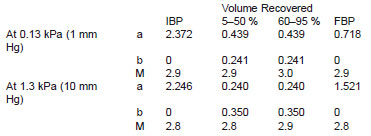ASTM D1160 standard test method for distillation of petroleum products at reduced pressure
11. Calculations and Report
11.1 Convert the recorded vapor temperature readings to Atmospheric Equivalent Temperatures (AET) using the equations in Annex A7.
11.2 Report the AET to the nearest degree Celsius corresponding to the volumetric percentages of liquid recovered in the receiver. Report also the identity of the sample, the density (measured in 8.3), the total amount of liquid distillate recovered in the receiver and in the cold trap before the vacuum source, any unusual occurrence such as foaming or burping, together with the measures that were taken to correct the problem.
12. Precision and Bias
12.1 Precision - The precision of this test method was generated from data obtained in a 1983 cooperative interlaboratory program with nine laboratories participating and eight samples being run. In this program, one laboratory used an automatic vacuum distillation analyzer and the results obtained with this equipment have been included in the data used to generate this precision statement. The precision of this test method is as follows:
12.1.1 Repeatability - The difference between two test results, in degrees Celsius, obtained by the same operator with the same apparatus under constant operating conditions on identical test materials would, in the long run, in the normal and correct operation of this test method, exceed the values indicated in Table 2 in only 1 case in 20.
12.1.2 Reproducibility - The difference between two single and independent results in degrees Celsius, obtained by different operators working in different laboratories on identical test material would, in the long run, in the normal and correct operation of this test method, exceed the values indicated in Table 2 in only 1 case in 20.
12.1.3 In Table 2, the rate of change in degrees Celsius (AET) per percentage of liquid volume recovered is shown as C/V %. At any point between the 10 and the 90 % point this value is assumed to be equal to the average value of C/V % of the two data points that bracket the point in question. In no case shall the span of these two points be more than 20 % recovered. An exception is the 5 % point where the span shall be not more than 10 %. See Annex A8 for an example.
12.2 The precision data in Table 2 have been computed from the following equations, which can be used to calculate precision data for C/V % values not listed.
12.2.1 Repeatability (r) can be calculated using the following equation:
r = M[e exp{a + b ln(1.8 S)}]/1.8
where:
r = repeatability, °C (AET),
e = base of natural logarithmic function, approximately 2.718281828,
a, b, and M = constants from 12.5.1, and
S = rate of temperature change (°C, AET) per volume percent recovered.
12.2.2 Reproducibility (R) can be calculated using the following equation:
R = M'[e exp{a' + b' ln(1.8 S)}]/1.8
where:
R = reproducibility, °C (AET),
a', b', and M' = constants from 12.5.2, and
S = rate of temperature change (°C, AET) per volume percent recovered.
12.2.3 See Annex A8 for an example.
12.3 To calculate precision data for pressures between 0.13 and 1.3 kPa (1 and 10 mm Hg), use constants calculated by linear interpolation from data given in 12.5.1 and 12.5.2.
12.4 Bias - Since there is no accepted reference material suitable for determining the bias for the procedure in this test method, no statement is being made.
12.5 Constants for Calculating: See Table 2.
12.5.1 Constants for calculating repeatability (r):

12.5.2 Constants for calculating reproducibility (R):

13. Keywords
13.1 atmospheric equivalent temperature (AET); boiling range; distillation; vacuum distillation



